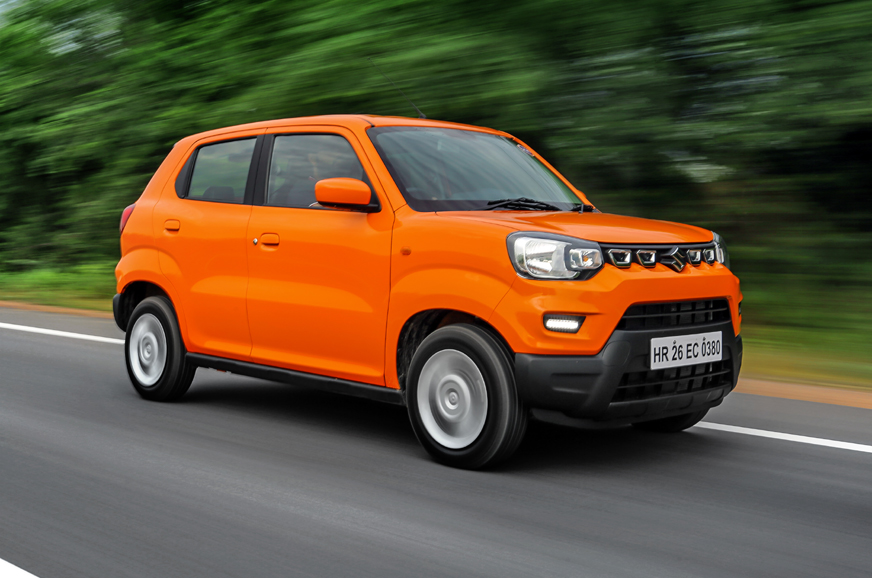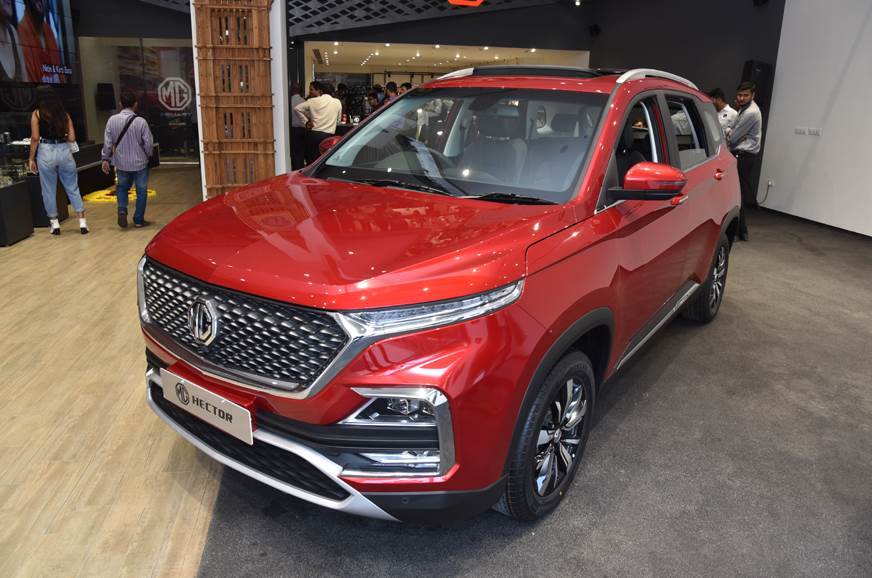
What is it?
There’s no textbook definition of an ‘SUV’ but over the years the term has been watered down from one used to describe rugged vehicles with some off-road ability to one that encompasses any vehicle that at the very least looks the part. With its upright design, relatively high ground clearance and elevated seating position, the Maruti Suzuki S-Presso has some of the elements that you’d associate with the latest vehicles of the type. Even so, to think of the pint-sized S-Presso as a ‘mini-SUV’ as Maruti Suzuki calls it, is a bit of a stretch.
With that out of the way, let’s switch focus from what the S-Presso isn’t to what it is. The S-Presso is Maruti’s latest budget model and one that’s aimed squarely at the ‘SUV-inspired’ Renault Kwid, itself fresh from a facelift. Built on Suzuki’s latest-gen Heartect platform, the S-Presso is far removed from older models like the Alto and Alto K10 that it will complement in Maruti’s line-up. There’s only one engine on offer – a BS6 version of the 1.0-litre K10 petrol engine – but buyers do get the option of manual and AMT auto gearboxes.
What’s it like on the outside?
Design and styling is a subjective matter but the S-Presso’s appearance really is an acquired taste. The upright pillars and relatively high set bonnet give the Maruti a somewhat SUV-like silhouette but the overall proportions are off. Measuring 3565mm long, 1520mm wide and 1549mm tall, the S-Presso appears too narrow for its height. Think first-gen Mahindra Scorpio and you’ll get the idea.
Maruti and Suzuki’s designers have tried to give the S-Presso’s front end some visual mass with chunky cladding on the lower portion of the bumper, and it does work to an extent. Some will also see a link to the latest-gen Jimny in the S-presso’s toothy grille that comes flanked by angular headlights. Do note, the chrome embellishments on the grille of the car pictured here are paid accessories, as are the LED daytime-running lights lower down on the bumpers. There are a lot more ways you can spruce up the S-Presso’s look and we’d recommend you consider the optional wheel arch and side cladding (not pictured here) that do much for the look. And if you don’t mind splurging there’s the option of machined alloy wheels too. The standard 14-inch wheels not only look boring but also a size too small amidst the large squared-out arches.
The S-Presso’s sides are pretty featureless and there’s nothing particularly remarkable about the tail either. The tail lights are simple in look but once again, you’ll find plenty of cladding at the rear bumper. A roof spoiler and skid plates are options for S-Presso buyers looking to do up their cars.
What’s it like on the inside?
Like its exterior, the S-Presso’s interior might also divide opinion. And that’s partly down to the centre-stacked instrument cluster. The speedometer doesn’t sit in the conventional position behind the steering wheel but takes pride of place at the top of the S-Presso’s very Mini-like circular centre console. Then again, the position of the instruments is something you get used to. The big font of the digital speedometer makes it easy to read but the odometer isn’t quite as legible and there’s no tachometer.
The circular centre console is also home to the infotainment system. Top-spec models feature Maruti’s latest SmartPlay Studio unit that comprises a 7.0-inch touchscreen. The screen is responsive, the menus are easily laid out and the system also gets you Android Auto and Apple CarPlay. Lower down are the knobs and buttons for the AC and heater.
If you aren’t too fussy about the position of the speedometer, you’ll actually have much to like about the S-Presso’s interior. The dashboard is smart and elements like the body-coloured embellishments around the centre console and side air-con vents do much to uplift the look. Cabin quality is also impressive by class standards. Of course, there are no soft touch plastics in here but material quality is good, fit and finish is consistent and the textured surfaces on the dash also work well. The steering is also good to hold.
And there’s more good news. The S-Presso’s interior feels airy and that’s not something you can say about the cabins of most budget cars. The high roof and large glass area help the impression of space. The front seats with their single piece backrests also score well on comfort and those of average height will like the view afforded from the high set seats. However, taller drivers will find themselves sitting a touch too high (expectedly there’s no seat height adjust) with a less than ideal view of the road. Larger headrests would also be part of our wish list.
The small, fixed rear headrests are a point of contention at the back too but otherwise the rear seat experience is surprisingly good. Even six foot tall occupants will find headroom sufficient and kneeroom ample at the back. That there’s enough space to tuck your feet under the front seats also aids comfort. The flat seat is also more supportive than it looks but it works best for two occupants; the cabin isn’t wide enough to seat three abreast in comfort. What’s missing at the back is a fold-down centre armrest that is a feature you get on the Kwid Climber.
Rear seat passengers get all but a single bottle holder at the back and will find themselves passing on items to those seated up front where there’s a bottleholder on each of the front doors, 2 cupholders, and even a shelf above the useable glovebox. There is plenty of room for luggage with the S-Presso’s boot seeming larger than its 240-litre capacity would suggest. A high lip and low boot floor makes loading heavy luggage a bit of a task but you’ll be quite pleased with how much you can fit into the back. The rear seat backrest also folds should you need more space.
What’s it like to drive?
The S-Presso’s three-cylinder, 1.0-litre petrol engine is easily one of the highlights of the new Maruti. Sure, its 68hp and 90Nm figure are only par for the course for this class of car but the engine is easily the best among budget cars. For starters, the 1.0-litre engine runs really quiet. The K10 engine was refined to begin with and the hardware upgrades required for BS6 emission norms have only enhanced it in this area. Idle is silent and even on the move you don’t hear all that much from the engine bay. The engine does get vocal when revved hard but that three-cylinder thrum is well contained here.
Performance is also good. Power delivery is smooth and the rev range is free from flat spots. The engine is also impressively tractable pulling cleanly from low revs even in a higher gear. That you don’t have to work the gearbox to get to the best of the engine makes the whole experience very user-friendly. The S-Presso builds speed with ease and you won’t have any trouble in typical urban environs.
The S-Presso’s standard fit 5-speed manual gearbox is also really nice to use. Gearshifts don’t need much effort and even the clutch is well weighted and easy to modulate. What also came as a pleasant surprise was the smoothness of the 5-speed AMT auto. To know how much AMT autos have evolved, you really need to have a go in the S-Presso. Gearshifts are timely and smooth, and the AMT-typical pause between shifts is also much shorter here. The AMT responds well to throttle inputs but for a quick overtake you’ll need to mash down on the throttle for the system to grant you the necessary downshift. Or you could just take manual control of gearshifts. In manual mode, gearshifts are quick and borderline fun too.
The S-Presso is an easy car to drive. The tight turning circle is a boon and the steering is also friendly. The lack of adequate self-centering at low speeds, a trait on all newer Marutis, remains a sore point but the steering is light and easy to twirl. In town, you’ll also appreciate the S-Presso’s impressive low-speed bump absorption. There is a hint of firmness in the suspension setup but this becomes more pronounced the quicker you go.
At highway speeds, the suspension can’t smoothen out surface imperfections so there’s always a bit of up-down movement. You do get a reasonable feeling of connect at the steering wheel and straight-line stability is fine, but the tall S-Presso doesn’t feel comfortable in sudden changes of direction. That the car weighs all of 760kg is a fact that’s sure to play on many people’s minds too.
Should I buy one?
The Maruti S-Presso is not a looker and you won’t be alone if you pass over it solely on the basis of its appearance. However, see the S-Presso for its merits and you’ll realize the list of positives is a long one. It’s got a relatively roomy cabin, it’s well equipped, it’s easy to drive and performance is good too. There’s also the promise of excellent fuel economy with the manual and AMT auto rated with an ARAI figure of 21.7kpl.
Prices for the S-Presso range from Rs 3.69-4.91 lakh (ex-showroom, Delhi) putting it in the same price bracket as the Renault Kwid. Whether or not it’s the better of the two models is something only a comparison will tell, but as is you’d do well to give the S-Presso a long, hard look.
from Autocar India https://ift.tt/2oSrOMV
via IFTTT

No comments:
Post a Comment